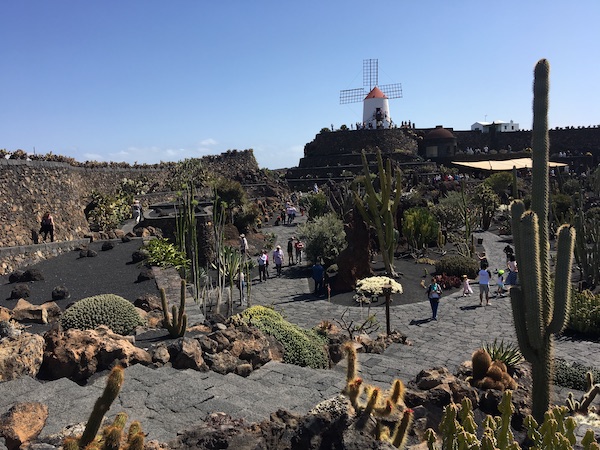By Rabbi Corinne Copnick

Last week I wrote about the immense, cathedral-like environment carved out of a lava tube on Canary Islands’ Lanzarote by inspired nature-artist Cesar Manrique. Among many other projects, he also created a huge, park-like, otherworldly environment, Jardin de Cactus, featuring more than 1,100 species of cacti planted in what was a disused quarry – that is, until Manrique, who is also an architect, decided to accent nature with art and vice-versa there. He and his talented team created an jaw-dropping garden of carefully landscaped and tended cacti, accented with red rocks, bridges, paved paths and even pools at different levels.
These are not little or even medium-sized cacti, oh no! Everything is grand in scale, plants that have been nurtured in the volcanic soil for many years. They range, according to the Jardin’s information, “from towering saguaros and spiny over-sized globes to more unusual species that resemble giant white maggots, thrusting asparagus spears, prickly mounds of broccoli, or dark green corals and sea anemones.” All have been planted in close proximity to one another in artistic patterns. The result, which took 20 years to complete, is astoundingly beautiful.
It was springtime when we visited, my daughter and I. And so many of the cacti were in bloom. It took my breath away. The word “awesome” seemed almost inadequate.
For me, visiting the Jardin de Cactus was a Heschel moment. Rabbi Abraham Joshua Heschel has long captured my imagination with his concept of “radical amazement,” which thankfully continues to influence every day of my life. As Heschel wrote about in his stellar books, “God in Search of Man: A Philosophy of Judaism,” and “Moral Grandeur and Spiritual Audacity,” that we should live our lives with a sense of wonder: to be spiritual is to be amazed. We should get up every morning with an appreciation of being alive, he explained, with a sense of awe at the mystery of life, and the desire to celebrate it.
That sense of wonder certainly resonated in me at the Jardin. It was springtime when my daughter and I visited. And so many of the cacti were in bloom in response to the balmy weather. It took my breath away. Although I understood that cacti have many practical uses in the desert, I didn’t know that cacti are actually flowering plants. The word “awesome” seemed almost inadequate.
I did know about the “monocarpic” century plant, so biologically labelled because it is a cactus said to bloom only once in 100 years (although some century plants have been known to bloom much sooner, perhaps in a few decades, depending on the climate, soil, and care they get). Unfortunately, after the century plant (horticulturally categorized as an “Agave americana”) blooms, it usually dies. I took a long look at one of the Jardin’s century plants; it reminded me of male worker bees who, once they mate with the Queen Bee, also die after this moment of glory.
It also reminded me that I still have a way to go before my final bloom. My human generation seems to have an unusual number of centenarians, so it’s comforting to know that at least a few century plants, like most cacti, are repeat bloomers.
Fortunately, most humans have the capacity to be repeat bloomers, as indeed Cesar Manrique’s many projects testify. The Jardin de Cactus was his last project – his final artistic bloom — completed in the 1990s. Two years later, he died in a car crash. His beautiful creations, however, live on in the volcanic soil. Truly awesome!
Awesome too, was the excitement of one of our fellow tourists, a retired surgeon from California, who was almost dancing with joy as he checked out the cacti in the garden. “I have two greenhouses at home, with 400 varieties of cacti growing,” he exulted. “And I can identify so many of the cacti in the Jardin. Of course, my cacti are little. I love to take care of them.”
“Do they bloom yet?” I asked this brilliant man, who had become our friend, who, after so many years of doctoring, still loved to care for living things.
“Not yet,” he replied. “But now I know they will.”
Our tour guide almost had to pull him out of the garden to rejoin the bus. He simply didn’t want to leave the cacti blooming, as if just for us, on a lovely spring day.
Recommended Video
Click link for video: Jardin de Cactus